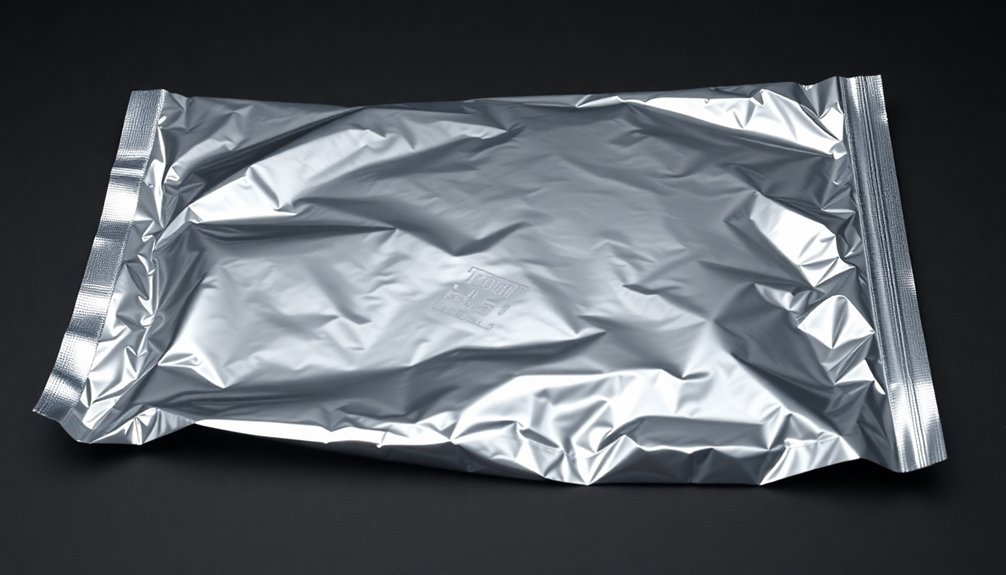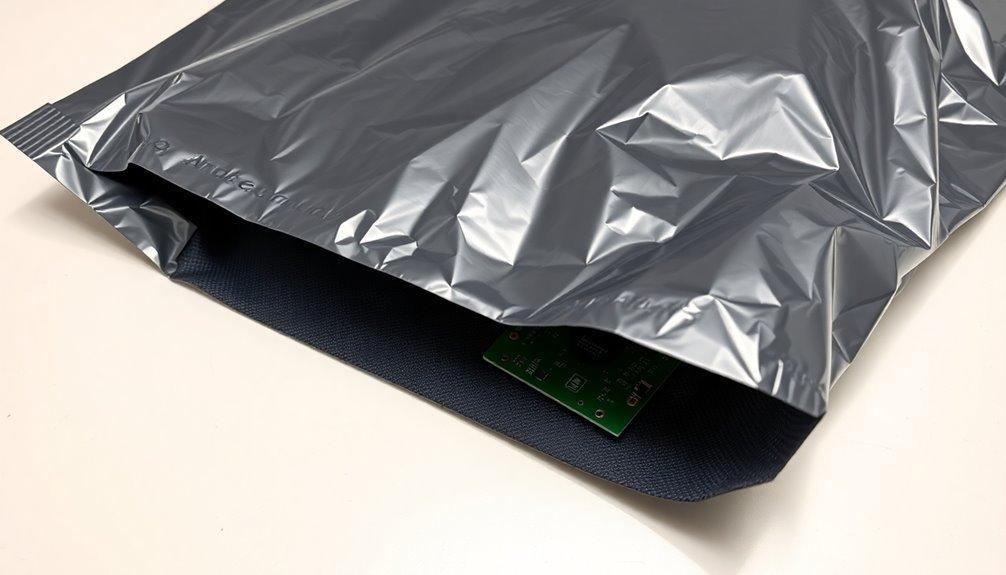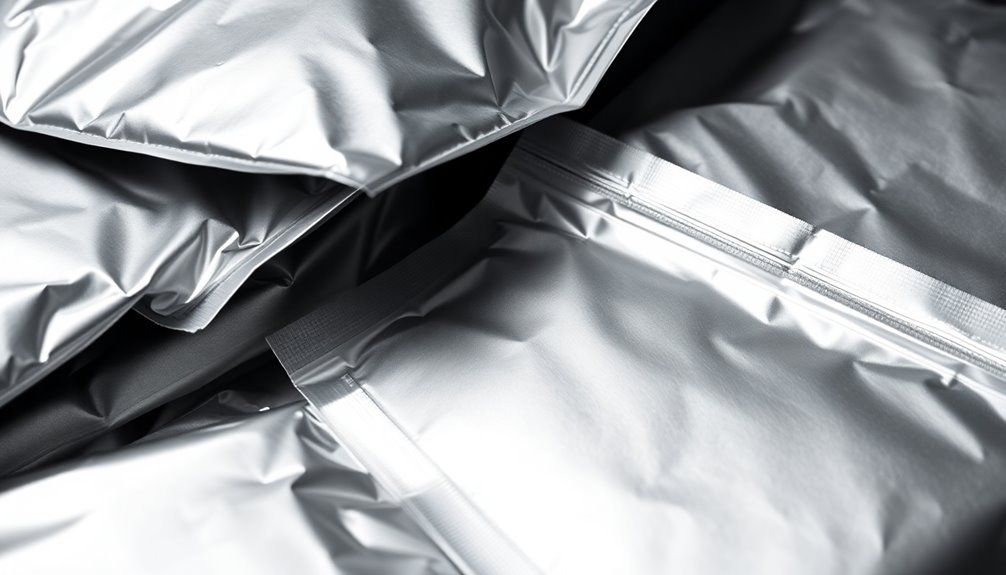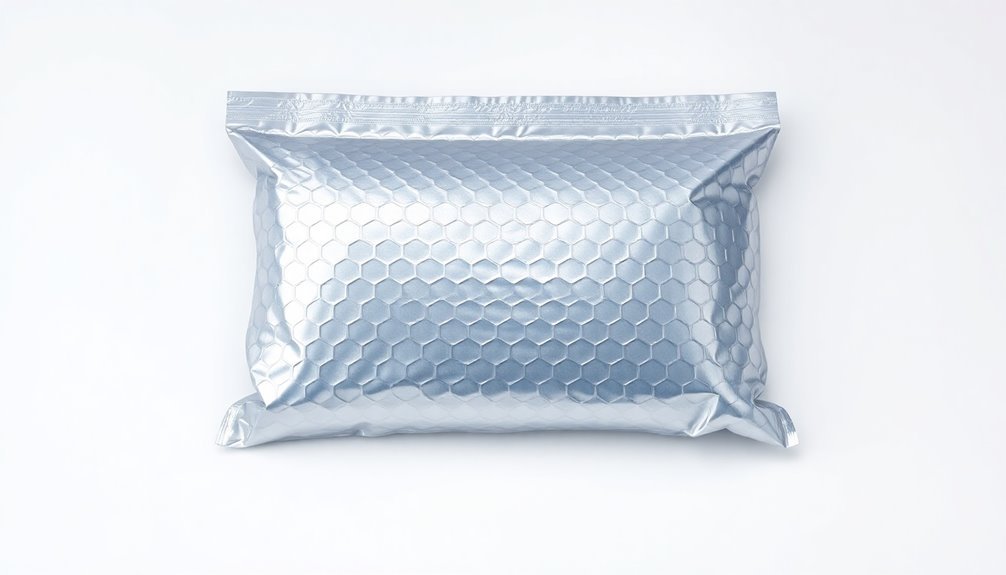Anti-static foil bags protect your sensitive electronic components from electrostatic discharge (ESD) damage during storage and handling. They're constructed with multiple layers, including static dissipative polyethylene and conductive metal, creating a Faraday cage effect that shields against harmful static charges. You'll find these bags essential for safeguarding items like circuit boards, memory chips, and other static-sensitive devices. They work by both dissipating existing static and blocking external electrical fields that could harm your components. Their specialized construction meets strict industry standards, and there's more to these protective barriers than meets the eye.
Understanding Anti-Static Foil Bags

Three key features define anti-static foil bags: their protective purpose, multi-layered construction, and specialized functionality. These specialized bags shield your electronic components from potentially damaging electrostatic discharge (ESD) while providing safe storage and transport solutions.
You'll find these bags are engineered with multiple layers that work together to protect your sensitive electronics. The inner layer consists of static dissipative polyethylene, while the middle layer contains aluminum that creates a Faraday cage effect. The outer layer typically features polyester with a static dissipative coating. Some variations even include a fourth layer for enhanced protection. These bags come in various protective colors, including pink, black, and metallic shades.
When you're working with electronic components, these bags offer dual protection. They'll dissipate existing static charges while simultaneously shielding against external static charges through the Faraday cage effect.
They're continuously working to remove and prevent static electricity buildup both inside and outside the bag.
You can rely on these bags for cost-effective protection in various applications, from military-grade electronics to standard components. When you need to transport or store ESD-sensitive items, they'll keep your components dry and safe from both mechanical and electrostatic damage.
Types of Static Protection
You'll find two main approaches to static protection: dissipative materials that slowly drain charges away, and shielding materials that block static electricity completely.
Static-shielding bags offer superior protection through their multi-layered construction, which includes both conductive and insulating layers working together as a Faraday cage.
While dissipative protection might be sufficient for less sensitive items, you'll need shielding protection for your most critical electronic components. The most effective static shielding bags utilize a four-layer structure that combines static dissipative coating, polyester, aluminum shield, and polyethylene for maximum protection.
Dissipative Vs Shielding Protection
All electronic components require some form of static protection during storage and transport, but not all protection types offer the same level of defense. When you're choosing between dissipative and shielding protection, you'll need to understand their distinct functions and capabilities.
Dissipative protection, typically found in pink poly bags, prevents static electricity build-up through special additives in polyethylene material. These bags allow charges to dissipate slowly, making them suitable for non-static sensitive parts in electronics manufacturing. Regular verification of certification compliance is crucial for maintaining quality standards.
Shielding protection offers a higher level of defense through multi-layer materials that create a Faraday Cage. You'll find these bags essential for static-sensitive electronics, as they protect components from both internal and external static charges.
They're built with a metalized protective layer and often meet military specifications like MIL-PRF-81705.
When selecting your packaging solution, consider your product's sensitivity to static. If you're handling non-static sensitive parts, dissipative bags will suffice. However, if you're working with static-sensitive electronics, you'll need shielding bags.
Remember that proper sealing is vital for shielding bags to maintain their ESD protection, and some varieties even offer additional moisture barrier protection.
Multi-Layer Defense Systems
Understanding multi-layer defense systems in anti-static bags reveals a sophisticated approach to protecting sensitive electronics. The typical construction consists of three primary layers, each serving a distinct protective function.
You'll find a static dissipative polyethylene inner layer that prevents charge buildup, a conductive middle layer made of carbon or aluminum that grounds charges, and a polyester outer layer with dissipative coating that removes external electrical charges. This advanced design is especially crucial for aerospace and medical industries where component protection is paramount.
When you examine static shielding films more closely, you'll notice they employ a four-layer structure. This includes a static dissipative coating on the outside, followed by a polyester layer that works with an aluminum shield to create a Faraday cage. The innermost polyethylene layer prevents tribocharge, maintaining a static-free environment for your components.
The multi-layer approach isn't just about quantity – each layer serves a specific purpose in the overall protection system. You're getting thorough defense through surface resistivity ratings between 10^4 to 10^6 ohms/square on the outer layers, while the internal layers work together to block external static fields, shield against dust, and protect from moisture damage.
How Static Shielding Works

Static shielding bags work through the Faraday cage principle, where a conductive outer shell redirects electrical charges away from sensitive components.
The multi-layer defense system in these bags starts with an outer dissipative layer that reduces static buildup, followed by a conductive middle layer that channels away charges, and finishes with an inner protective layer that safeguards your electronics. This protection is crucial since static electricity damage costs the electronics industry billions of dollars annually in losses.
When you place components inside a properly sealed static shielding bag, you're fundamentally creating a protective shield that blocks external electrical fields while safely dissipating any internal static charges.
Faraday Cage Protection Principles
Static shielding bags employ a fundamental physics principle known as the Faraday cage effect to protect sensitive electronics from electromagnetic interference and static discharge. When you place an electronic component inside these bags, the conductive metallic layer creates an electromagnetic shield that prevents external electric fields from reaching your device.
The bags work by rearranging electrical charges in their conductive layers. When an external electric field approaches, the charges within the bag's metallic layer redistribute themselves to create an opposing field that cancels out the incoming one. Similar to Michael Faraday's original 1836 invention, these bags demonstrate the same protective principles.
You'll find this protection is especially effective because the bags are made with multiple layers, including a metalized protective layer that enhances the Faraday cage effect.
The effectiveness of your static shielding bag depends on several key factors. The bag's conductivity, material thickness, and seal integrity all play vital roles in its shielding capability.
While grounding isn't necessary for the Faraday cage effect to work, it can improve the bag's performance by providing a path for excess charge dissipation. You'll get the best protection when the bag is properly sealed and free from tears or punctures.
Multi-Layer Defense System
While the Faraday cage effect provides the foundation for static protection, the real power of static shielding bags lies in their sophisticated multi-layer construction.
You'll find three primary layers working together to create a thorough defense system against static electricity. These bags offer convenient re-closable designs for secure access to stored components.
The inner layer consists of static dissipative polyethylene that prevents static buildup from occurring inside the bag where your sensitive components rest.
Moving outward, you'll encounter the middle metallic layer, typically made of aluminum or carbon, which acts as the primary shield by collecting and grounding static charges.
The outer layer features polyester with a specialized static dissipative coating that handles external electrical charges before they can penetrate the bag.
Some manufacturers add extra layers to enhance puncture resistance and strengthen the seal, making the bags more durable for shipping and handling.
Each layer plays a vital role in protecting your electronic components, creating a robust barrier against both internal and external static threats.
This multi-layer system meets strict industry standards like ANSI/ESD S20.20 and IEC 61340-5-1, ensuring your sensitive electronics remain safe during storage, transportation, and handling.
Essential Features and Materials
Three essential layers form the foundation of anti-static foil bags, each serving a crucial protective function for sensitive electronics. The inner layer consists of static dissipative polyethylene that prevents static buildup near your components.
In the middle, you'll find a layer of carbon or aluminum that collects and grounds charges, while the outer layer uses polyester with a special dissipative coating to remove external charges.
You'll notice these bags are built to stringent specifications, typically maintaining a thickness of 140μm ± 10μm. The materials work together to create a Faraday cage effect, protecting your electronics from both ESD and EMI.
When you're handling sensitive components, you'll appreciate that these bags are heat-sealable and come in various sizes to match your needs.
The multi-layer construction meets ANSI/ESD STM 11.1 standards for resistance and friction voltage, ensuring your components stay safe during storage and shipping. You'll find different configurations available, including metal-in and metal-out film bags, letting you choose the most appropriate protection level for your specific electronic components.
Protection Levels and Standards

Protection standards for anti-static foil bags follow rigorous international requirements, including ASTMD257, ELA541, and MIL-B-81705. You'll find that these bags must maintain specific electrical properties, with volume resistivity between 1 x 10^4 and 1 x 10^11 ohm-centimeter, and surface resistivity below 1 x 10^5 ohm/square.
When selecting anti-static bags, you'll encounter two main protection levels:
- Static Dissipative Bags – These prevent static buildup through a dissipative coating on standard polyethylene, making them suitable for non-critical environments but offering limited protection against external charges.
- Static Shielding Bags – These provide superior protection through a Faraday cage effect, using conductive metal layers for sensitive components.
The bags you choose must maintain their protective properties during storage, shipment, and use, regardless of environmental conditions.
They shouldn't outgas or contain harmful substances that could damage your electronic components. For critical applications, you'll want to verify that your supplier provides certification documentation proving compliance with these standards.
Testing Standards – Your bags should comply with ANSI/ESD STM11.31-2018 for shielding capabilities and ANSI/ESD STM11.11-2022 for surface resistance measurements.
Storage and Handling Guidelines
Proper storage and handling of anti-static foil bags makes all the difference in maintaining their protective qualities.
You'll need to store them in a cool, dry place away from direct sunlight, which can weaken their protective properties. Keep them away from static generators like carpets and synthetic fabrics, and verify the storage area maintains low humidity levels.
When you're handling these bags, always touch the exterior to avoid contact with the inside surface. Don't slide components in and out quickly, as this could damage the bag's interior.
You should use static dissipative materials and wear a grounding strap or wristband to discharge any static electricity from your body.
Before sealing an anti-static foil bag, press out excess air and verify the seal is tight and secure. If you're using re-sealable bags, check that the closure mechanism is working properly.
Don't fold or crease the bags, as this can compromise their protective layers. For additional protection of sensitive components, you can include desiccant pouches and moisture indicators.
Remember to inspect bags for damage before use and replace them if you notice any compromise in their protective layers.
Frequently Asked Questions
Can Anti-Static Bags Be Reused Multiple Times?
You can reuse anti-static bags multiple times if they're undamaged and made of polyethylene. However, you shouldn't reuse metallic-layered bags, as they're prone to deterioration and might not protect your electronics effectively.
How Long Do Anti-Static Bags Maintain Their Protective Properties?
Your anti-static bags typically maintain protective properties for 2-5 years when properly stored. However, you'll notice their effectiveness can decrease with frequent reuse, exposure to moisture, or physical damage.
Are Anti-Static Bags Recyclable?
You'll find most anti-static bags aren't easily recyclable due to their complex material composition. While some specialized facilities can process them, it's best to check with your local recycling center for specific guidelines.
Do Anti-Static Bags Protect Against X-Rays During Airport Security Scanning?
No, your anti-static bags won't protect electronics from X-rays during airport scanning. They're only designed to prevent electrostatic discharge damage. If you're concerned about X-ray exposure, consider alternative screening options.
Can Regular Plastic Bags Be Converted Into Anti-Static Bags?
You can't convert regular plastic bags into anti-static bags since they lack essential dissipative materials, special coatings, and multilayered construction. It's best to purchase proper anti-static bags for protecting your electronics.
In Summary
You've learned how anti-static foil bags protect sensitive electronic components through multiple layers of defense against static discharge. By using these specialized bags correctly, you'll prevent costly damage to your electronic items during storage and transport. Remember to maintain proper handling procedures, check the bags' protection ratings, and always store your components in an appropriate anti-static environment for the best results.





Leave a Reply